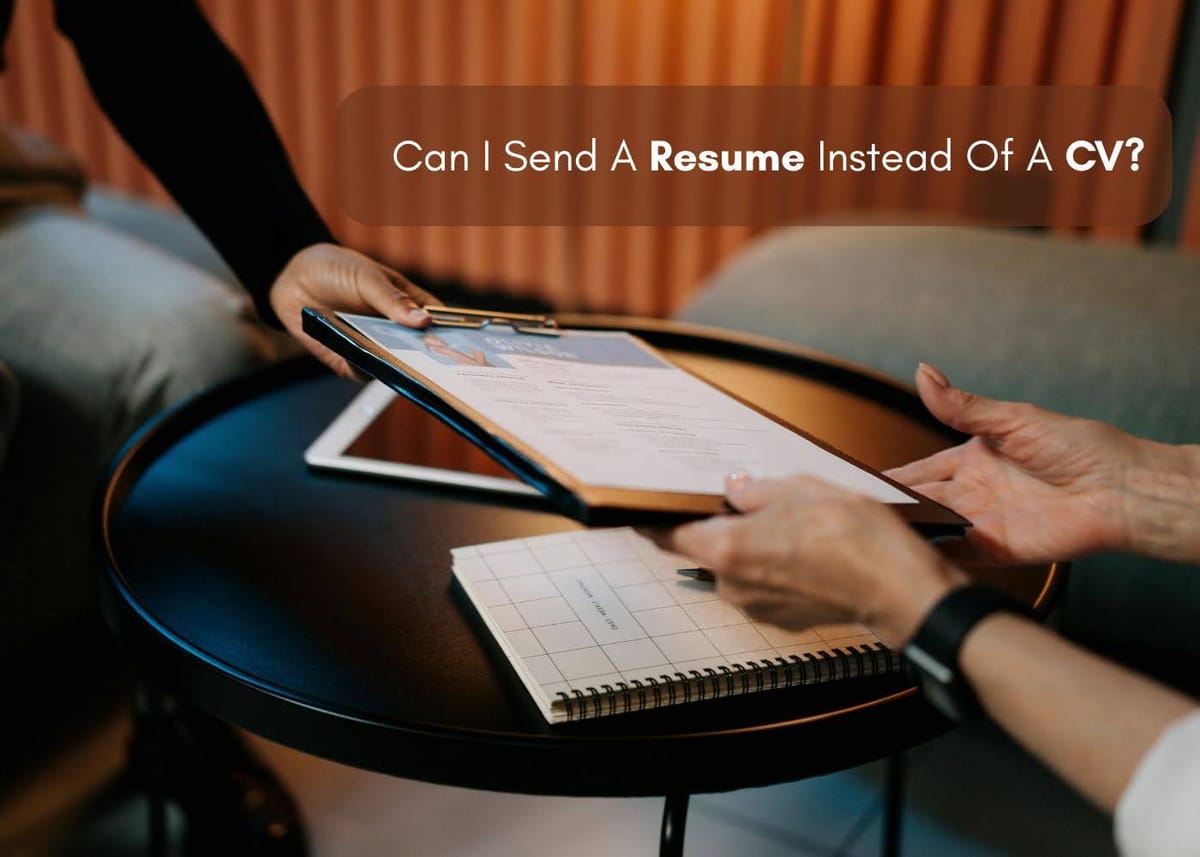Can I Send A Resume Instead Of A CV?

You've found your dream job posting, and you're ready to apply. But wait, the application asks for a CV, and you only have a resume. Can you send your resume instead? Or maybe it's the opposite scenario. Either way, you're stuck wondering if you're about to make a career-limiting mistake by submitting the wrong document.
If you're confused about curriculum vitae vs resume requirements, you're not alone. In fact, 73% of job seekers report feeling uncertain about which document to submit during their job search. The good news? We're here to clear up the confusion once and for all.
Let’s dig deep into the world of curriculum vitae and resumes, explore their distinct roles, and discover how to choose the right tool for your career journey.
So... Is Resume CV? Not Even Close
Here's where people get confused. Some folks use "resume" and "CV" like they're the same thing. Is resume cv? Nope. Not even a little bit.
Think of it this way:
- CV = Your professional memoir
- Resume = Your highlight reel
A resume is like your career's greatest hits album. One to two pages max, featuring only the tracks that'll get you on the playlist for that specific job you want.
What is a resume?
A resume is typically a one to two-page document that highlights your most relevant skills, experience, and achievements tailored to a specific job. It focuses on brevity and readability, ensuring hiring managers can quickly gauge your qualifications.
Important elements include:
- Professional Summary
- Employment History
- Skills and Qualifications
- Tailored Career Objective
What Exactly Is a Curriculum Vitae?
A curriculum vitae (Latin for "course of life") is a comprehensive document that details your entire academic and professional history. A CV provides an in-depth overview of your educational background, professional experience, research, publications, and other academic or specialized accomplishments. While resumes serve most corporate and industry positions, CVs are preferred for academic, research, and international job applications.
Key Features of a CV:
- Length: Typically 2-10+ pages (grows throughout your career)
- Content: Exhaustive career history including:
- Complete education details
- All work positions held
- Research experience and publications
- Conference presentations
- Awards and honors
- Professional affiliations
- Sometimes even hobbies and interests
- Customization: Generally static, you add to it but rarely remove content
- Geographic Usage: Standard in Europe, Asia, Africa, and for academic positions globally
The curriculum vitae format follows a chronological structure, starting with your most recent achievements and working backward. Unlike a resume, a CV is meant to paint a complete picture of your professional journey.
Key Differences Between a CV and a Resume
For many job seekers, the distinctions between these documents can be confusing. Here are the key differences between a CV and a resume to help you figure out which is right for your situation:
- Length: CVs can be 10+ pages; resumes max out at 2 pages
- Detail Level: CVs are exhaustive; resumes are selective
- Customization: CVs remain mostly static; resumes are tailored per job
- Geographic Norms: CVs dominate in Europe/Asia; resumes rule in the U.S./Canada
- Industry Usage: CVs for academia/research; resumes for corporate roles
- Career Stage: CVs grow throughout your career; resumes stay concise
- Format Flexibility: CVs follow strict chronological order; resumes can be functional or combination
- Personal Information: CVs may include personal details; resumes strictly professional
- References: CVs often list references; resumes typically don't
- Application Speed: CVs take longer to review; resumes enable 7-second scanning
Understanding the differences between CV and resume will help you decide what to present. For example, if you’re wondering, "Should I submit a resume or CV for grad school?", typically, grad school programs require a CV that details research experience and academic achievements.
When Should You Send a Resume vs CV?
Send a Resume When:
- Applying for corporate jobs in the U.S. or Canada
- The posting specifically asks for a "resume"
- You're targeting private sector roles
- The position isn't research or academia-focused
- You need to pass ATS (Applicant Tracking System) screening
Send a CV When:
- Applying for academic positions (professor, researcher, postdoc)
- Seeking positions in Europe, Asia, or Africa
- The job posting explicitly requests a "CV" or "curriculum vitae"
- Applying for medical residencies or fellowships
- Pursuing government research positions
But Wait... Should I Submit a Resume or CV for Grad School?
Ah, the eternal grad school dilemma. Should I submit a resume or CV for grad school? Here's the deal:
- Master's programs: Usually want a resume. Keep it tight, keep it relevant.
- PhD programs: CV all the way, baby. Show off that research experience.
- MBA programs: Resume. Those admissions folks have seen enough CVs to last a lifetime.
- Medical/Law school: Check. The. Requirements. Seriously. Every school is different.
Transforming Your CV to a Resume (and Vice Versa)
Sometimes, you might have extensive experience documented in your CV, but need to pivot to a concise resume for a specific job application. Knowing how to change a CV to a resume can be a valuable skill. Here’s a step-by-step guide:
- Identify the Essentials:
- Focus on the job description and pull out the key skills and experiences that are most relevant.
- Prioritize your most recent and impactful experiences.
- Trim Down the Content:
- Remove outdated or less relevant details (e.g., early career roles not related to the position).
- Limit your document to 1–2 pages.
- Refine the Format:
- Use resume format best practices: bullet points, clear headers, and a clean layout.
- Tools like a CV maker or CV examples online can offer inspiration for designing your new resume.
- Highlight Achievements:
- Replace lengthy descriptions with quantifiable metrics (e.g., “Increased sales by 25% in six months”).
- Emphasize the professional summary that aligns with your career objectives.
- Customize Each Application:
- Tailor your resume for each job. Even slight tweaks can make a significant impact.
Let's Talk Format (Because Looks Matter)
Curriculum Vitae Format (The Traditional Approach)
Your curriculum vitae format should be clean, chronological, and comprehensive. Think:
- Clear sections with bold headers
- Chronological order (newest first)
- Consistent formatting throughout
- Times New Roman or Arial (yeah, boring but effective)
- Plenty of white space so it doesn't look like a wall of text
Whether you go with curriculum vitae format Word or curriculum vitae PDF, keep it simple. This isn't the place for creative fonts or colorful designs.
Resume Format (Where You Can Have Some Fun)
Resumes? You've got options:
- Add a splash of color (one accent color, not a rainbow)
- Use modern fonts (but keep them readable)
- Include a skills section with those keywords HR loves
- Make those bullet points pop
Just remember: ATS (Applicant Tracking Systems) hate fancy formatting. So maybe save the creative version for networking and keep an ATS-friendly version for online applications.
CV Examples and Resume Samples (What Works and What Doesn't)
Looking at CV examples online can be overwhelming. Half of them look like they were designed in 1995, and the other half are trying way too hard.
Good CV/Resume Elements:
- Clear contact information (duh, but you'd be surprised)
- Quantified achievements ("Increased sales by 45%" not "Responsible for sales")
- Relevant keywords from the job posting
- Clean, readable formatting
- Zero typos (seriously, proofread that thing)
Bad CV/Resume Elements:
- Your photo (unless you're applying in Germany or something)
- "References available upon request" (we know)
- Objective statements from 2003 ("Seeking a challenging position..." Ugh.)
- Every job since high school
- Hobbies (unless super relevant - like you're applying to REI and you've climbed Everest)
International Considerations (Curriculum Vitae Translation)
If you're applying internationally, understanding curriculum vitae translation goes beyond language, it's about cultural adaptation:
- Europe: "CV" often means what Americans call a resume (2-3 pages)
- UK: They might want personal details Americans would never include
- Germany: Photo required (weird for Americans, normal for Germans)
- Japan: Specific format called "rirekisho" - don't even try to wing it
Understanding Related Documents
Difference Between Resume and Cover Letter
While we're clarifying document types, let's address another common confusion, the difference between resume and cover letter:
- Resume: Your professional snapshot (what you've done)
- Cover Letter: Your personal pitch (why you're perfect for this role)
- CV: Your complete professional history
All three serve different purposes in your job application toolkit.
Traditional Job Search vs. Scale Jobs’ Human + AI Model
To give you a clearer picture, here’s a side-by-side comparison of the traditional job search process versus Scale Jobs’ innovative approach:
The Scale Jobs Advantage
Here's the reality, understanding differences between CV and resume is just the first step. You still need to:
- Tailor each document for every application
- Ensure ATS compatibility
- Track which version you sent where
- Follow up appropriately
This is where Scale Jobs transforms your job search. Our human + AI approach means:
- Expert Review: Real humans ensure you're sending the right document type
- Custom Tailoring: We adapt your CV or resume for each specific role
- Volume + Quality: Apply to 250-1000 jobs without sacrificing personalization
- Time Savings: 93% of our clients land jobs within 3 months
Conclusion
Look, the whole difference between CV and resume thing doesn't have to be rocket science. Most of the time, if you're applying for regular jobs at regular companies, you want a resume. Short, sweet, tailored to the role.
Save the CV for when you're going after that professor gig or research position where they actually want to know about every paper you've published since grad school.
The real secret? Whatever document you send, make sure it tells a clear story about why you're perfect for THAT specific role. Because at the end of the day, whether it's 2 pages or 20, it's all about connecting your experience to their needs.
Now stop reading about resumes and CVs and go apply for something! Your dream job isn't going to apply for itself.
FAQs
Q1: What is the fastest way to apply to jobs in the U.S.?
The fastest way is to use a service that automates job applications through ATS-friendly resumes and covers letters. Scale Jobs applies for you using a human+AI hybrid method, often resulting in callbacks within 12–24 hours.
Q2: Is it acceptable to send a resume instead of a curriculum vitae?
Yes, provided that the employer’s guidelines align with this choice. In the U.S., for most industry roles, a tailored resume is preferred, while CVs are typically required for academic or research positions.
Q3: What are the key differences between a curriculum vitae and a resume?
A CV is a comprehensive document covering your full academic and professional history, whereas a resume is a concise, targeted overview suited for specific job applications.
Q4: Should I submit a resume or CV for grad school?
Grad school applications typically expect a CV that outlines your academic achievements, research projects, and publications in detail.
Q5: How can I change a CV to a resume?
Focus on trimming down your content by emphasizing only the most relevant skills and experiences, and adopt a concise resume format using bullet points and quantifiable successes.




![[UPDATED-2026] Job Search Strategies That Actually Work: Tips + Best Tools](/content/images/size/w600/2025/12/image-1764688576191.jpeg)